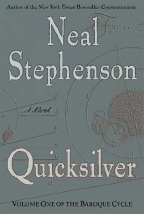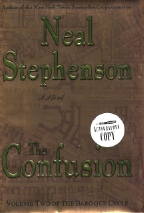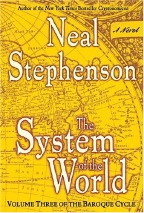e've been through
quite a bit together readers, have we not? Space Opera has strutted
its stuff across this stage, and fantasy has fought final battles
for a variety of objects -- swords, spells [1],
damsels and domains. Mysteries have unfurled and been solved (pronounced
solv-éd,
not solv'd). Horrors have been unleashed and then put to rest, or
not. Literary dramas have played out with significance to last the
ages. The very Arts themselves have cried forth of wonders,
terrors, and authors who release too few novels for the comfort of
their dear,
dear Readers.
|

|
Nothing
to see here. Move along, move along.
|
Here we are, in the midst of the High Future, having left the iconic
dates of 1984 and 2001 behind. We've walked upon the moon and found
it dull enough to the tastes of our governments -- bent on conquest
and capital -- that we've not returned. Satellites circle the earth
so that our children can send text messages to one another in classrooms
that were old when the first satellite was launched, bringing forth
a reign of terror. If they could put a satellite in the sky, we told
ourselves, then surely they could drop a nuclear bomb amidst our
busy cities. We're still afraid of nuclear devices, but not those
dropped from space. Why bother, when you can pack one in a suitcase?
Our fears have evolved, but the objects of those fears remain the
same.
In order to soothe our troubled minds in this unexpected High Future,
we seek the solace of literature, fine writing that engages the mind
in a fashion that has not changed since the invention of written
literature itself. Having been through every troubled trope in the
Dictionary, having invented new words and phrases to fill that dictionary,
we're now seeking that sweet forgetfulness in the words and forms
of ages long past.
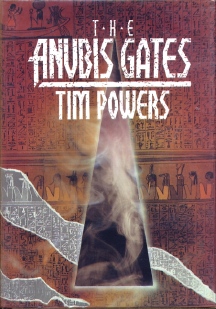 |
|
| A
classic novel about Victorian times that is nonetheless
not "New Victoriana". |
When I speak
of "New Victoriana", I want to be perfectly
clear. I'm not simply speaking of those novels that treat the Victorian
ages as their subject. Novels of this type have been around since
the Victorian age. One should perforce mention Tim Powers 'The Anubis
Gates', 'The Stress of Her Regard' and 'On Stranger Tides' as three
high-points. William Gibson and Bruce Sterling collaborated on the "steampunk" genre-defining
novel 'The Difference Engine', set in a Victorian London of steam-powered
computers. Caleb Carr's 'The
Alienist' and 'The
Angel of Darkness'
were compelling serial killer stories set in a beautifully detailed
post-Victorian New York. Yes, each of these novels were compelling
stories that created the foetid atmosphere of Victoriana. But even
if the narrators -- some of them first-person -- were inhabitants
of the Victorian ages, none of the novels were written in the precise
cadences of Victorian-era fiction. These novels were about Victorian
times, but they themselves were not New Victoriana.
For the purposes of this discourse, novels of the "New Victoriana" will
be defined as those titles I point to. Well, that, and of course
a general stipulation that novels in the "New Victorian" mode
would be those that use the Victorian style of storytelling. If I've
missed something obvious, please write to tell me, but be assured
that it's included as well. One need not have all the tell-tale signs
to get in the doors of the club. But the novels that do stand out
from their brethren. They flaunt their slightly intrusive omniscient
narrators. Their language trends towards affect. In fact, "trends" is
perhaps too light a word. Their language is heavily affected, with
curious and often arbitrary-seeming spelling. And yet, while the
diction strays towards the antiquarian, it does not quite match
the challenging nature of actual Victorian prose. It offers the
semblance
of Victorian prose, but not the substance.
Chapter titles are a plus. Footnotes will practically guarantee you
a passing grade. Labyrinthine plots, huge casts of characters, often
listed either before or after the novel itself are features that
lend themselves to New Victoriana. A novel written in this mode will
often feature the weird -- but not always. Remember that the Grand
Master of Victorian Literature, one Charles Dickens, himself was
a supernatural novelist. Indeed, his most famous work, one that has
been revised into utter unrecognizability, that is, 'A Christmas
Carol', is no less than a ghost story. It features, in fact no less
than three ghosts. One feature of Mr. Dickens' work that New Victoriana
loves to resurrect is his peculiar naming convention. These days,
it is not only in a Dickens novel that one might encounter a Mr.
Feebletoss, or a Missus Rumblebutter. Such creatures have been given
life once again, their authors having lashed themselves to a steel
pole in the moors in the midst of a literary lightning-storm. My
readers will know that I'm fond of illustrated books. But New Victoriana
requires illustrations of a certain kind, if you know what I mean
and I think you do. And if not illustrations then maps are always
welcome.
|

|
"Let us imagine then, how Law might have waited upon Equity."
|
Let us then, get on along with our discourse and actually name a
title or two in this heretofore-mysterious oeuvre. New Victorians
like to reach back into the past -- but not too far into the past.
I'm going to take a hint and go back only to 1989, when I encountered
what to me is the Grandfather of New-Victoriana, Charles Palliser's
wonderful tome 'The Quincunx'. Weighing in at a hefty 788 pages,
'The Quincunx' was Mr. Palliser's first novel, and it took him a
mere twelve years to research and write. Fix that number in our minds
readers; we're going to make use of it later in this essay. In the
interim, know that 'The Quincunx' is the modern model of New Victoriana.
If you seek the gentle pleasures of intrusive narrative, they are
here. Witness this opening passage:
"It must have been late autumn of that year, and probably it was towards
dusk for the sake of being less conspicuous. And yet a meeting
between two professional gentlemen representing the chief branches of law
should surely not need to be concealed.
Let us imagine then, how Law might have waited upon Equity."
Thus
begins the epic tale of a young man cheated of his inheritance,
forced into penury, launched into an adventure that will take
him across all strata of London's society. Readers can see the
affect,
and note the ways I which the author has made that affect enjoyable
to read and experience. The change in the reading experience
by virtue
of the mannered style of the prose is one of the primary pleasures
of New Victoriana. For years, readers have been told that transparency
is the key to great reading and writing. Writers have studiously
written themselves completely out of their own narratives. The
language is almost seen as an impediment.
But in New Victoriana, the comforting sensation of a storyteller
not too far from the reader, a presence that wants to be known
but not in the way is ever there. Palliser and all the authors
in this
mode play with the device, some suggesting that the reader will
eventually meet the storyteller, others carefully hiding the
narrator behind
a partition from whence he shall never emerge. And be assured
readers that narrator is a "he" no matter what the sex of the
author may be.
But I was referring to the delights of Mr Palliser's work, and
they are many. Mr Palliser meticulously creates the labyrinthine
feel
of the Victorian novel, with so many characters and families
that the reader needs a scorecard. And like any good New Victorian
novelist,
Mr Palliser provides several scorecards. After the narrative
pages, you will find a family tree that includes not only characters
who
are in the novel, but many who are not in the novel. You will
find a curious sigil that symbolizes the relationships between
four
families. You will find an "Alphabetical List of Names" nearly
four full pages long. And readers, you shall consult those family
trees
and that list of names numerous times. While I never thought of
it when I was actually reading the novel, should I read it again,
I
might make a photographic copy of these lists so that I could refer
to them while I was reading without flipping to the back.
And would I read it again? Why, yes I would. For the novel is
immersive and involving in the best of senses. When you are reading
this
novel, you can count on the world of the novel replacing the
tawdry world
you will find yourself in once you close the covers. The language
is so rich as to almost induce a drunken stupor, an intoxicating
delight, without any of the deleterious effects that over-consumption
of liquor bring about. Recalling all the mention of families
and family trees, this novel makes a powerful statement about
the very
nature of families, that statement being, in the parlance of
the current day, "Families are really, really complicated. And Dangerous." And
in making that statement over the length of 788 pages, the novel
backs up its thesis with every word. Mr Palliser himself is a delightful
narrator, one whom the reader can count upon to provide a wonderful
time. Yes, 'The Quincunx' will do quite well as the "Patient
Zero" of New Victoriana.
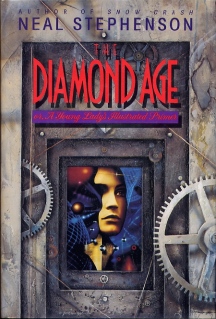 |
|
| ...or,
A Young Lady's Illustrated Primer. |
Hopping along
the time line, the world of New Victoriana remains quiet until
the year of our Lord 1995. Then, an enterprising
Young Man in the world of scientifiction, or as it is known
now "science
fiction" managed to have a most peculiar novel published. Using
the tropes of his genre, young Neal Stephenson decided that he would
declare the mid-21st century as 'The Diamond Age'. In this tome,
he tells the story of one young Nell, a member of the "thetes",
the dirt-poor urchins of Mr Stephenson's future. Through a
positively Victorian series of circumstances, she comes upon
a machine that
is called A Young Lady's Illustrated Primer. From this she
learns all manner of knowledge normally forbidden to one of
such low birth.
And with this knowledge she will encounter a destiny unfurled
in a curious admixture of New Victorian devices and rather
jarringly
21st century prose.
Yes readers, having made a rule or two, I've rather broken them
almost immediately. But after all, isn't that what they're for?
For slotting
'The Diamond Age' into this deluge of New Victoriana is something
of a stretch to be sure. But it is nothing if not an informative
stretch. And yes, Stephenson does mitigate his prose with very
Victorian Chapter separations and headings, all the while keeping
his atmosphere
quite New Victorian as well. And yet, not only is novel about
a Primer. The novel itself is a primer.
That's because -- jumping ahead, and breaking another rule,
damn me to regions infernal -- Stephenson would once again
return
to the convoluted world of New Victoriana with his latest set
of novels,
three enormous tomes any one of which might choke a dray-horse,
but
all three of which might break either the horse's back or the
reader's brain -- were it not so enchantingly written. Mr Stephenson
wrote
an entertaining novel of the present, 'Cryptonomicon', released
in 1999. He then disappeared from the "New Fiction" shelves
until last year, four forgivably long years given that the result
is The Baroque Cycle. The three novels that comprise this enormous
and complex tapestry -- 'Quicksilver', 'The Confusion' and the forthcoming
'The System of the World' (HarperCollins, October 1, 2004, $27.95)
-- offer no less than the story of civilization itself, of technology,
of the world as we know it. That story is perforce a complex conspiracy,
an arcane archaeology, through which we find meet personages both
historical and invented.
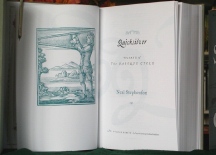 |
|
| The
very Baroque limited edition of Quicksilver. |
Stephenson's
brilliant mind has done nothing less than re-invent The World As
We Know It in a series of novels
that, while they eschew many of the principles of Victorian
storytelling -- the intrusive narrator, the antiquarian spellings,
the chapter
titles the author himself made use of in 'The Diamond Age'
-- firmly assert a Victorian style of historical romance so detailed
one feels
the need, the desire to re-read it even as one reads it the
first time. And this desire to re-read is not born out of an inability
to understand, but rather a desire to experience at a greater
depth
the pleasures provided by an author of positively astonishing
talent. What's more, a smallish publisher that goes by the moniker "Hill
House" have undertaken to publish lavishly
baroque versions [2] of each volume of the Baroque
Trilogy. Not only do you have the impetus to re-read in the
text, these versions of the novel
give
you a real,
physical nature to undertake a re-reading. The beauty of the
books is such that you will no doubt want to confine yourself
to your
parlour and use your reading gloves. It is presumed, of course
that you have
both a parlour and reading gloves. If not, please take the
opportunity to obtain them. A glance at their home page informs
me that 'The Confusion' is now available in a limited edition.
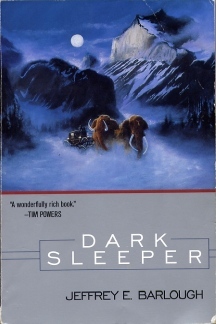 |
|
| An
unfortunate cover for Mr.Barlough's fine first novel. |
Readers are having
their patience tried, I'm sure, eager to get to what they might perceive
of as the "main course",
that is the forthcoming novel that even as I write is being
boxed and
shipped in quantities not seen since a certain to this reader
odious title squatted at the top of the bestseller list. But
first it
is incumbent upon me to mention work as fine as any work mentioned
in this article, that of an antiquarian iconoclast named Mr.
Jeffrey Barlough. I must say that I can hardly believe that
it is only
four
years since Mr Barlough's first novel, 'Dark Sleeper' was released.
Since then, we've seen only two others; 'The
House in the High Wood' and this summer's 'Strange Cargo'. Readers, let me assure
that Mr.
Barlough's work deserves to be read by every one of you immediately.
It is of the highest caliber, and moreover, utterly and perfectly
in the New Victorian tradition. Few have used this tradition
as effectively as Mr Barlough, and none have displayed the
vivid and
unexpected
imagination displayed by Mr. Barlough in these novels.
|
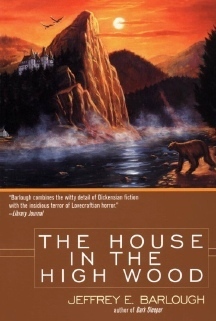
|
A terrorizing but subtle novel told in a faultlessly Victorian prose style.
|
The three books
comprise a sort of rough series in that they are all set in the same
place. Since they are uniformly excellent,
I'd recommend reading them in order. Moreover, the first two
are
available
at a remarkable discount. In correspondence with one of my
readers, who shall henceforth be known as Mr. Rowerbazzle,
I was told
that "the
indispensable bookcloseouts.com currently
has his first two books on sale for three and two dollars respectively." I
implore you make use of this information and immediately. The Western
Lights[3] series is set in a world that is so uniquely
conceived that readers
will find themselves propping their jaws up regularly as they
read. The city of Salthead and environs are fog-shrouded and
age-haunted.
Imagine the streets of Victorian London transported to the
San Francisco
Bay. The hills are populated by mastodons and sabre-toothed
tigers. The mastodons are used as work-creatures, to haul wagons
between
the more distant points on this landscape. Clues within the
narrative entertainingly suggest a world torn asunder at some
point in the
distant past by a meteor or comet strike. But what's left is
a pocket of Victorian-era civilization in a world where the
boundaries
between
reality and the surreally supernatural are far too porous.
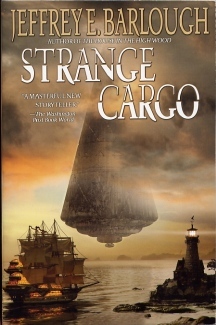 |
|
| A far nicer cover illustration graces this fine novel. |
'Dark Sleeper'
introduces Barlough's world and unto that world it introduces a
supernatural menace that is terrifying and
imaginative without any of the unpleasant violence or grue
that often mars
the
so-called horror of today. But what 'Dark Sleeper' most importantly
introduces is a unique fictional voice. Barlough makes use
of every New Victoriana technique he can lay his hands on,
and where
none
exist, he's able to invent them. The author is something
of an antiquarian himself. He's not "on the Internet" and he confines himself
to old-fashioned "mail', that delivered by humans instead
of electrons. He edits journals of authentic antiquarian
literature. He is not simply a denizen of our age who is
interested in
the aged
work of yesterday. He lives and breathes this work and it
shows in every enjoyable sentence he writes. His novels are
textbooks
of the
New Victoriana. He offers character lists, chapter titles
and characters named Mr. Nicholas Crabshawe, Mr. Ham Pickering
and professor Titus
Vespanius Tiggs. His narratives slowly and reassuringly crank
up the weird, but his demons and deities are not coil-driven
felines.
They are fully fleshed yet fleshless creatures that enable
Barlough to create incomparable chills amidst considerable
charms. Few readers
will forget the conclusion of 'The House in the High Wood'.
I require a spot of warmth even on a bright sunny day simply
recalling it.
His newest novel, 'Strange Cargo' (Ace/Penguin Putnam, August
3, 2004, $14.95) finds one aptly named Frederick Cargo setting
sail
in search of an inheritance. One can guess that this will
not
be the boon Mr. Cargo hopes it to be.
What Barlough does best, however, and perhaps better than any
other writer today, is to make use of the New Victoriana prose-style.
His
narrators are ever present and often, eventually introduce themselves.
Their identity may offer a key to the story being told. But in
any event, the voice is so delightful, the tales are so imaginative,
that one simply cannot ask for a more entertaining or rewarding
reading
experience. And by virtue of Barlough's high style, one is forced
to thank the New Victoriana school of literature for the pleasure
one is afforded when reading these fine books.
|
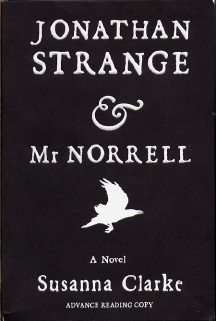
|
A lavishly detailed and complex supernatural soap opera in perfect New Victoriana style.
|
All of which
brings me to the latest and certainly one of the most notable
additions to this fine school of literature.
'Jonathan
Strange and Mr Norrell' by Susanna Clarke (Bloomsbury,
September 8, 2004,[6]
$28.95) offers nearly the full spectrum of New Victoriana
flourishes in a compact 800 page book-brick. Readers are
now adjured to
recall
my earlier mention of Mr. Palliser's epic twelve-year struggle
to write and research 'The Quincunx', his first novel.
Ms. Clarke underwent
a similar battle to finish her novel, but in my humble
estimation it was worth the wait -- though I certainly hope we
won’t have
to wait so long for another! I must confess that I entertained
strong feelings of doubt as to the worthiness of this novel.
The only term
that is properly applicable is that ungainly word "hype",
short for hyperbole. The hyperbole associated with Ms Clarke's
novel made me severely uncomfortable. I was both doubtful
and fearful that
it would live up to the praise bestowed upon it. The first
words I heard were from a well-known bookseller who repeated
the since
oft-used phrase "the adult [mumbly-mumble]".
I'm not certain who coined that phrase. Certainly it was
someone
with commerce
in
their eyes and little in their brains. Whatever it might
be, 'Jonathan Strange and Mr Norrell' is certainly not
that. I've
not completed
reading the novel, so I'm offering not a review but rather,
a progress report.
As 'Jonathan
Strange and Mr Norrell' begins, it is 1806 in England and the titular
Mr Norrell manages to trick
the York
Society
of Magicians into turning over all their texts on theoretical
magic.
As the narrative
unfolds, it becomes clear that this is not exactly the
England with which we are familiar. Nor is the form of
storytelling
with which
we are exactly familiar, for Susanna Clarke shows from
page one a determination to re-invent the Victorian tome
for so-called "modern" readers.
We are offered a novel with chapter titles and lovely,
understated illustrations by Portia Rosenberg. One can
quite comfortably
imagine the illustrations accompanying a serial version
of the novel run
in 'The Strand' magazine, be it the original of the Victorian
age or the current revival, done in equally fine style.
I rather wish
that Ms Clarke had seen fit to include endpaper maps for
the unschooled-in-English geography American audience of
whom I
am a member. And I confess
to some small surprise at the lack of a list of the dramatis
personae. But neither of these is an issue once one plunges
into the narrative.
There, the reader will find a comfort unlike any available
in the average modern novel. For all the size of the novel,
the cast of
characters is fairly short and easily remembered. The prose
retains the mannered aspects of the best new Victorian
fiction, but reads
without effort. In fact, as I mentioned above, there's
a comfort and a confidence here that makes the reading
experience
particularly
enjoyable. It's also much easier to read than one might
expect. The pages melt away without effort.
For those who were actually hoping for an "adult &tc &ct",
prepare to be disappointed. The titular Mr Norrell is a very disagreeable
sort, churlish, selfish and highly insecure. Once he decides to re-invigorate
the "English tradition of magic", he moves to London, where
he falls under the sway of two rather disreputable hangers-on, Mr
Drawlight and Mr Lascelles. They convince him that he needs a powerful
act of magic to start his career, advice he unwisely follows. For
to do so, he's forced to ask the assistance of one of the residents
of the world of Faerie, a certain "thistle-haired man",
so-called because of the mass of whitish hair atop his
head. This proves to be an unfortunate decision. It is,
in fact,
the beginning
of an invasion.
Jonathan Strange does not show up until well in the narrative.
He's a dissolute gentlemen looking for an occupation to interest
him,
and he hits upon magic. He proves to be rather good at it, and
eventually manages to become the pupil of the reticent Mr Norrell.
The two have
quite different styles, and eventually they clash. But neither
of them is the enemy.
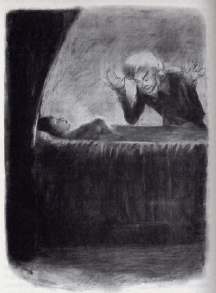 |
|
| "At
the sight of Miss Wintertowne the gentleman with the thistle-down
hair suddenly became very excited." An illustration by
Portia Rosenberg. |
While the veritable reams of press would have this novel as a
sort-of battle of dueling magicians, I would describe it as an
alternate
history in which England has a nearly-lost technology of magic
that must be brought to bear again to repel an invasion from
a supernatural
reality. Clarke's faeries and the world they inhabit are the
real stars here. Yes, Ms Clarke has performed an amazing scholarly
feat.
She's certainly created a remarkably detailed alternate history
of England, one in which an organized and detailed system of
magic once
ruled. She extends the reach of her New Victoriana by inserting
scholarly and very Victorian footnotes throughout the text. Some
of these footnotes
might be publishable as stand-alone short stories. Her system
of magic really does seem like a system, with a complex history
of success,
failure and documentation. One can imagine shelves of notebooks
crammed with faux histories. Better still, one can imagine the
histories
themselves, since many are detailed in the footnotes and the
narratives.
But as I said, the real stars here are Clarke's sinister faeries.
She imbues them with the perfect balance of menace, malice and
malevolence. Better still, the humans that surround them are
utterly clueless
as the nature or even existence of their enemies. The influence
of the faeries makes itself felt in enchantingly surreal moments,
when
characters suspect they may be slipping into a dream state. For
readers who like sly and intelligent antagonists who have both
great power
and great limitations, for readers who like understated menace,
Clarke provides a cornucopia of literally enchanting reading.
While the prose does have the general feel and appearance
of the best of New Victoriana, Clarke manages to somehow
make
it all read
quite easily. There's a rather compulsive feel as one reads
the novel, though the action is carried out over so many
pages and
in such detail
that it can't properly be called a "page-turner" most
importantly because lending it that appellation might suggest
that the novel
is vapid, and it most assuredly is not vapid. It's not
profoundly meaningful either, and that's all for the best.
'Jonathan
Strange and Mr Norrell' reads like dream, footnotes and
all. For those
who like to become lost within the pages of a very long
book, this is
an excellent novel.
Readers must take my word with an important precaution. The story
is, in theory, building up to a nice climax. However, I'm about
220 pages from the final words. I don't think that it's possible
that
the novel could be this confidently written and end up nowhere,
but stranger things have happened. But thus far -- and this is
in fact
only a progress report, not a final review -- 'Jonathan Strange
and Mr Norrell' is standing up as a fine piece of fiction and
a sterling
example of New Victoriana.
Readers who are interested in obtaining this tome will have to
wait until September 8 to get the hardcover version being
released in
America and September 20 to get the hardcover version being
released in the UK. I know of more than a few readers who will
demand
both. Ms Clarke is about to launch a tour of the American
territories[4] that
will enable readers to obtain her signature on the the
first editions being shipped even as I write this. Should circumstances
prove this
to be the enormous success that the publishers are anticipating,
those first editions will be worth quite a bit more than
their
cover price. In addition, much has been made in the News section of this
venerated E-zine about the limited edition,[5] which I
suspect my readers managed to buy out almost single-handedly.
What this
adds up to is
a bevy of books that readers will be loathe to take to
the tacqueria
to read during lunch. A reader who wrote me --let us call
her MAD -- suggested that those of us who would like
to preserve our editions
may obtain the trade paperback from Canada. In her wisdom,
she
suggested we search via a certain unnamed Canadian vendor
via this key: 0747574111.
I will leave it to the more diligent readers here to determine
what use to make of this information. I merely suggest
that having more
than one copy of this book will prevent at least one copy
from being stained with hurled-about foodstuffs.
|
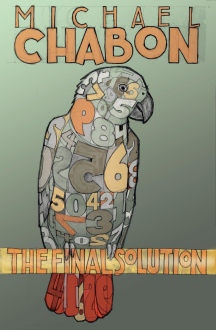
|
Your first look anywhere at the cover of Michael Chabon's latest novel, a fine example, I suspect, of new Victoriana.
|
No less a literary giant than Michael Chabon will soon be
offering his own contribution the New Victoriana oeuvre,
the compact and
intriguingly titled 'The
Final Solution: A Novel of Detection'.
Originally published
in the Paris Review, where it won a prize, this novella (at
least in it's original incarnation) offers up a new adventure
for the
un-killable Sherlock Holmes that includes just a dash of
the fantastic. Chabon
is certainly one of our most distinguished literary authors
and seems bound and determined to offer a contribution to
the world
of genre
fiction as well. On his website, he describes this book thusly:
"My novella, "The
Final Solution," which
first appeared last year in The Paris Review, will be published
on December
1 by Fourth Estate (HarperCollins). This will be a special,
small-format hardcover, with a stunning cover and six interior
illustrations
by
Jay Ryan."
Chabon is
a man endeared of the throwback. He forcibly mutated a respectable
literary quarterly, 'McSweeney's
Quarterly
Concern' into
'McSweeney's Mammoth Treasury of Thrilling Tales', sending
shockwaves of abreaction throughout the genre fiction
establishments. The
resulting editorial hemming and hawing was provided an
enjoyable spectacle.
He averred the power of "plotted fiction". He's
demonstrated throughout his career his ability to give
genre fiction a literary
infusion that actually makes the final result a better
reading experience. I'm confident his experiment in New
Victoriana
will be -- in fact,
already was -- successful. Having missed the Paris Review
Summer 2003 Issue, I'll eagerly await this ornamented hardcover
version.
In the interim, I will continue my journey towards the
end of the tale of 'Jonathan Strange and Mr Norrell',
wringing every
bit of
enjoyment I can from every word the author has written.
From this smattering of books both old and new, it's
clear that New
Victoriana
will continue to thrive, and indeed, become widely known
and respected throughout the literary landscape. One
hopes that those
who enjoy
the obvious and easy-to-find works will take the trouble
to seek out their lesser-known counterparts. I shall
await that curious
future, which shall, at least in literary terms, resemble
more and more the
past from whence it emerged.
|





